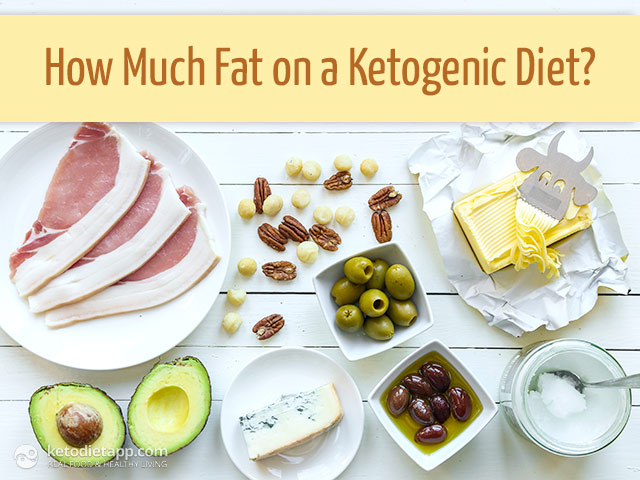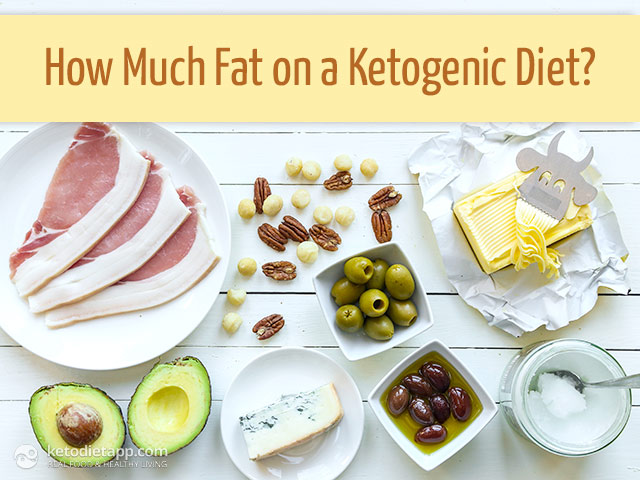
Do calories matter? How much fat can I eat to lose weight on a ketogenic diet? These are just some of the many questions I focused on when writing this post.
What’s the Ideal Fat Intake on a Ketogenic Diet?
As most of you know, ketogenic diets are high in fat, adequate in protein and low in carbohydrates. The aim of the ketogenic eating is to get your body into a state known as ketosis. Generally, the macronutrient ratio varies within the following ranges:
- • 60-75% of calories from fat (or even more),
- • 15-30% of calories from protein, and
- • 5-10% of calories from carbs.
However, percentages are relative and don’t say anything about the amount of calories you are eating. Percentages will give you an idea of the macronutrient composition of a diet. To determine the amount of calories, you have to look at absolute numbers – macronutrients in grams. So it’s totally different to consume 4,000 kcal and 2,000 kcal on a ketogenic diet.
Can I Eat less than 60% of Calories from Fat?
Yes, you can. Since you only regulate your energy intake via fat when following a ketogenic diet (protein and carbs remain more or less constant), you may end up eating less than 60% of calories from fat, especially if you are trying to lose weight. This is perfectly fine.
In his bestselling books and also in this video, Dr. Stephen Phinney explains the different phases of the ketogenic diet. Depending on your goal, your fat intake will vary in each phase and you will lose different amount of body fat. Weight loss slows down and it’s completely natural – you will lose more weight at the beginning (water weight + accelerated fat loss) so don’t get discouraged if your weight loss slows down as you get close to your target weight.
Why You Need to Use a Keto Calculator
Not everyone follows the ketogenic diet to lose weight. Many people do it for medical reasons (cancer, epilepsy, etc) while athletes and bodybuilders use it to enhance endurance and muscle development. All groups of keto dieters can benefit from knowing their macronutrient requirements. This includes people that simply try to lose weight and feel better.
Contrary to what many people believe, calories do count, even on a ketogenic diet. When you eat nutritious foods low in carbs, moderate in protein and high in fat, most people will naturally eat less. For this reason, most of you won’t need to count calories on a keto diet.
However, just following a ketogenic diet doesn’t guarantee weight loss. It helps to keep an eye on your fat intake. The closer you get to your target weight, the more important that becomes. Additionally, you need to ensure that you’re eating sufficient amount of protein to stay satiated and prevent muscle loss.
My keto calculator will give you recommendations depending on your goal (weight maintenance, weight loss or weight gain). The calculations I used are based on widely accepted research and recommendations made by Dr. Volek and Dr. Phinney. We put a lot of effort to ensure that unlike some other calculators, you get sensible results that will help you with your diet.
How Much Fat for Quick Weight Loss?
You should never use the ketogenic diet as a "quick fix" for your binging days. If you decide to follow a low-carb approach, you should see it as a new and better life-style rather than just a temporary diet experiment. Contrary to what you may have heard, there is no magic tool or supplement that will "burn" all those extra pounds of body fat for you.

You will lose weight if you stick with the basic KetoDiet rules – just don’t have unrealistic expectations. Some people simply lose weight faster than others. That’s because apart from their macronutrient intake, there are several other factors to consider (gender, age, health condition, activity, etc). If you haven’t succeeded by following the ketogenic diet, chances are you need to start monitoring your calorie intake.
The best way to lose weight is to find a calorie deficit that you feel comfortable with. You can opt for a larger calorie deficit but you should not feel hungry when you follow the ketogenic diet. If you do, you are either not eating enough protein or fat, thus calories. For most people, a moderate calorie deficit (15-20%) is a great way to start.
Don’t Fall for the Extra High Fat Myth
I’d like to address a myth frequently seen in the low-carb community. I’ve seen people following a very low-carb diet who cannot lose weight. To my surprise, they are often advised to increase their fat intake and decrease their carb and protein intake. This is supposedly going to help them enhance ketosis and break through a weight loss plateau but it’s simply wrong. Your calorie intake matters and it’s not all about going as low on carbs as possible. In fact, you don’t even need to be in ketosis or show high ketone readings to lose weight.
While the optimal carb level for some is 20-30 grams of net carbs, others may do better with more or less carbs – it’s down to individual needs and body responses.
My good friend, Franziska Spritzler, also known as the Low Carb Dietitian – and one of the experts I recommend on my blog – has written an excellent post about the misconceptions surrounding the ketogenic diet. I strongly recommend you read the full post on Franziska’s blog. Below in an extract:
"A ketogenic diet containing less than 20 grams of net carb daily can produce weight loss provided energy intake is reduced, which often occurs spontaneously with carb restriction. There’s no denying that many people experience dramatic weight loss with minimal carb intake, are able to maintain the loss, and feel great eating this way. But some of the statements I’ve read about keto being a miracle for dropping unwanted pounds are simply untrue, such as:
- • You can eat as much fat as you want as long as you keep your carbs really low, because fat doesn’t stimulate insulin secretion (I’ve seen the phrase, "The more fat you eat, the more weight you’ll lose.")
- • If you’re eating very low carb and not losing, you need to reduce your protein and increase your fat intake to at least 75% of your calories.
- • You should aim for the highest serum ketone levels possible to ensure maximal fat burning; i.e., you’ll lose more weight if your serum beta-hydroxybutyrate level is 3 or 4 mm than if it’s 0.5 or 1 mm."

Is a "Zero-Carb" Diet Better for Weight Loss?
The suggestion that a "zero-carb" or a very low-carb approach (less than 20 grams of total carbs) leads to a higher level of ketones and enhanced fat loss is misleading – this is not how the ketogenic diet works. The main reason why you’ll lose weight on a ketogenic diet is simple: you’ll naturally eat less because low-carb diets have appetite-suppressing effects. Additionally, following a low-carb approach will help you release and utilise your fat stores more effectively. Although some people see better results with less carbs, most people won’t benefit from a "zero-carb" approach.
Most people that do "zero-carb" believe that higher ketone levels will help them lose weight. There is no scientific evidence to support that. That’s why supplements that boost ketone levels do nothing for weight loss. If you want to lose weight, just stick with the diet. Typically, a zero or very low carb approach is desirable purely for therapeutic purposes rather than weight loss.
A carbohydrate-restricted, mildly ketogenic diet is a better way to manage weight in the long run. It’s easier to stick with and provides sufficient micronutrients. I personally follow a ketogenic diet with 30-50 grams of net carbs and 2000 kcal (for weight maintenance) or 1600-1700 kcal (for weight loss).
How Do I Get Enough Fat on a Ketogenic Diet?
When you start following a ketogenic diet, you have to increase the amount of fats. And it’s not any fats – it’s the healthy fats.

Getting most of your daily calories from fat is easier than you might have thought. You don’t even have to introduce large amounts of pure fat like butter or coconut oil to your meals – your food doesn’t have to taste greasy. Avocados, eggs, macadamia nuts or salmon are all great sources of healthy fats for your ketogenic eating. And even if you find it difficult to increase your fat intake, check out the hundreds of recipes on my blog and also this ketogenic food pyramid.
When increasing your fat intake, it’s important to understand which fats are beneficial and which may damage your health. Simply put, the type and quality of fats matter.
Use the Right Types of Fats
Avoid unhealthy processed fats and oils at any cost. Processed vegetable oils, margarine, hydrogenated oils or trans fats are all damaging your health.

For cooking: Use oils and fats high in saturated fats (SFA) – ghee, lard, tallow, coconut oil, etc. Additionally, for light cooking, you can use oils high in monounsaturated fats (MUFA) like olive oil, avocado oil and macadamia oil.
For cold use: Use oils high in MUFA and polyunsaturated fats (PUFA) like nut and seed oils. If you want to use these oils for cooking, add them at the end of the cooking process or after the food is cooked.
Not All PUFA are Equal

Opt for oils high in omega-3 fatty acids, ideally from animal sources (fatty fish like salmon, mackerel or sardines). You can also get your omega 3s in quality supplements like fermented cod liver oil. Apart from being a great source of omega 3 fatty acids, it’s high in vitamin D that is deficient in modern diets. Due to the nature of my job (mostly working in front of my computer and not getting enough sunlight), I was deficient in vitamin D, even though I was eating fatty fish 2-3 times a week. I’m taking cod liver oil every day!
Watch your consumption of omega-6 rich foods – beware that even some keto-friendly foods like almonds and walnuts should be consumed with caution. This doesn’t mean that you should avoid nuts altogether – just eat them in moderation.
Cooking Method Matters

Even when you use heat-stable fats, it doesn’t mean that you should fry all your food. Braising in a slow cooker is one of the healthiest methods to prepare food. Although most of us just quickly fry their bacon on a pan (yes, I’m guilty of that too), this report shows that cooking bacon on a lower temperature for longer is the best way to avoid carcinogenic nitrosamines. I usually cook mine at 275 F / 135 C for 30 minutes. Not all keto-friendly foods are healthy, especially when they’re burned.
For a complete overview of healthy fats and oils including smoke points, shelf live and oxidation rate, check out my Guide to Fats & Oils.
Do you like this post? Share it with your friends!

I changed the way I ate in 2011, when I was diagnosed with Hashimoto’s, an autoimmune disease that affects the thyroid. I had no energy, and I found it more and more difficult to maintain a healthy weight.
That’s when I decided to quit sugar, grains, and processed foods, and to start following a whole-foods-based ketogenic approach to food.
OnKeto.com is a news aggregation service that brings you best of world articles to you for your consumption.
Author: Martina Slajerova
Author URL: https://ketodietapp.com/Blog/author/martina
Original Article Location: https://ketodietapp.com/Blog/post/2015/12/07/how-much-fat-on-a-ketogenic-diet
